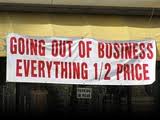 Join me deep in the weeds of accounting! The last time I went this deep in the weeds the beloved editor of the Prophecy Podcast blog commented that the post was mind-numblingly boring. This is even more deep into things as it discusses a rather obscure part of accounting. Yes, accounting. Ugh.
Join me deep in the weeds of accounting! The last time I went this deep in the weeds the beloved editor of the Prophecy Podcast blog commented that the post was mind-numblingly boring. This is even more deep into things as it discusses a rather obscure part of accounting. Yes, accounting. Ugh.
I had a discussion about this over coffee at the Cambridge House Conference I attended. The two other coffee drinkers were talking about the conference and I mentioned how inflation affected the profit and loss of a business. Since they are expecting inflation, what I said was shocking to them.
LIFO and FIFO are two different accounting methods used for allocating inventory to the profit and loss for the business. (Sorry to have to slog through this.)
Here is how Wikipedia describes the two accounting methods.
 FIFO and LIFO Methods are accounting techniques used in managing inventory and financial matters involving the amount of money a company has tied up within inventory of produced goods, raw materials, parts, components, or feed stocks. These methods are used to manage assumptions of cost flows related to inventory, stock repurchases (if purchased at different prices), and various other accounting purposes.
FIFO and LIFO Methods are accounting techniques used in managing inventory and financial matters involving the amount of money a company has tied up within inventory of produced goods, raw materials, parts, components, or feed stocks. These methods are used to manage assumptions of cost flows related to inventory, stock repurchases (if purchased at different prices), and various other accounting purposes.
FIFO stands for first-in, first-out, meaning that the oldest inventory items are recorded as sold first but do not necessarily mean that the exact oldest physical object has been tracked and sold.
LIFO stands for last-in, first-out, meaning that the most recently produced items are recorded as sold first. Since the 1970s, some U.S. companies shifted towards the use of LIFO, which reduces their income taxes in times of inflation, but with International Financial Reporting Standards banning the use of LIFO, more companies have gone back to FIFO. LIFO is only used in the U.S.
I am expecting moderate inflation in the 10 to 20% range for a couple of years. Others are expecting deflation; others are expecting hyperinflation. But for discussion purposes let’s talk about how a 33% inflation rate would affect a business.
 Let’s say that there is a retail business with an inventory of $750,000 in widgets. This is a C Corp that pays 35% in taxes. (Yes, I am aware that the rate varies.) The corporation pays any wages that are due to shareholders. The corporation is able to keep the same number of widgets as before with great effort through the year, but now has $1,000,000 in inventory. But in terms of cash flow, the business is in the same situation it was before. What is the taxable income of the Corporation? If you said zero you would be right, if the corporation is using the LIFO accounting method. But if the FIFO method is being used, then the taxable income is $250,000.
Let’s say that there is a retail business with an inventory of $750,000 in widgets. This is a C Corp that pays 35% in taxes. (Yes, I am aware that the rate varies.) The corporation pays any wages that are due to shareholders. The corporation is able to keep the same number of widgets as before with great effort through the year, but now has $1,000,000 in inventory. But in terms of cash flow, the business is in the same situation it was before. What is the taxable income of the Corporation? If you said zero you would be right, if the corporation is using the LIFO accounting method. But if the FIFO method is being used, then the taxable income is $250,000.
At 35% this is a tax of is $87,500. Where is this money supposed to come from? The business has barely managed to break even with the heavy inflation rate of 33%. This is why many corporations now use the LIFO method.
So what is the big deal? Obama, in his never-ending search for new taxes, is proposing to abolish LIFO accounting. While this is an old proposal, it will continue to be offered until it is passed. Under normal circumstances this will just be a modest increase in taxes for most businesses. But for those with inventory that has a volatile price surge history, like say the lumber that I sell, it can be a major tax increase in a year. To be fair it can also result in a tax decrease if prices drop. A smaller inflation rate would be survivable for a business, but for many businesses it would be the proverbial straw that broke the camel's back. With hyperinflation and FIFO accounting every retail business in the US would close.
 Coming soon to a business near you. I can see a business surviving with high inflation and forced to FIFO accounting and the resultant tax for a year, maybe two, but then businesses will start closing. A tax on the phantom income due to inflation has the potential to close retail stores—remember that Safeway is a retail store.
Coming soon to a business near you. I can see a business surviving with high inflation and forced to FIFO accounting and the resultant tax for a year, maybe two, but then businesses will start closing. A tax on the phantom income due to inflation has the potential to close retail stores—remember that Safeway is a retail store.
This is what was shocking to my coffee companions. The effect of this stealth tax could be extremely destructive and it is not on anyone's radar right now. It should be.
CORPORATE TAX RATES
|
TAXABLE INCOME |
RATE |
|
Up to $50,000 |
15% |
|
$50,001 – $75,000 |
25% |
|
$75,001 – $100,000 |
34% |
|
$100,001 – $335,000 |
39% |
|
$335,001 – $10 million |
34% |
|
Over $10 million – $15 million |
35% |
|
Over $15 million – $18,333,333 |
38% |
|
Over $18,333,333 |
35% |
|
ALTERNATIVE MINIMUM TAX* |
20% |
* The corporate AMT exemption of $40,000 is phased out with alternative minimum taxable income between $150,000 and $310,000.
This chart is the technicalities of Sub C Corporation Taxes.